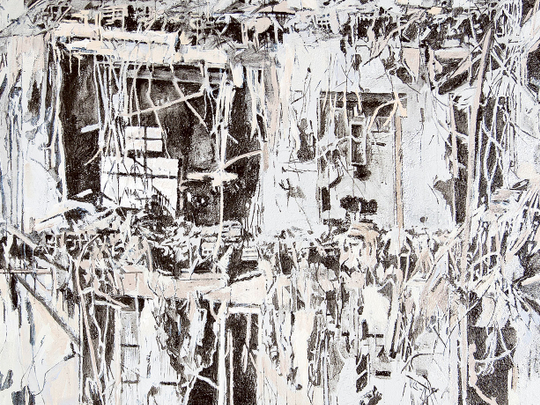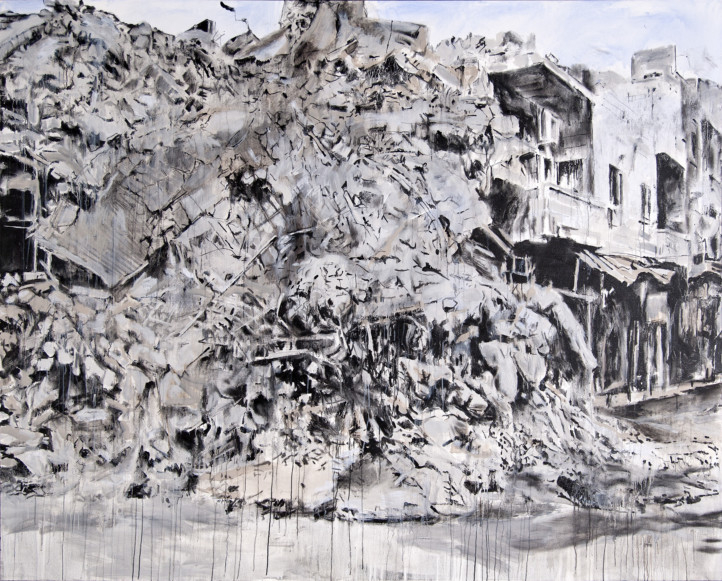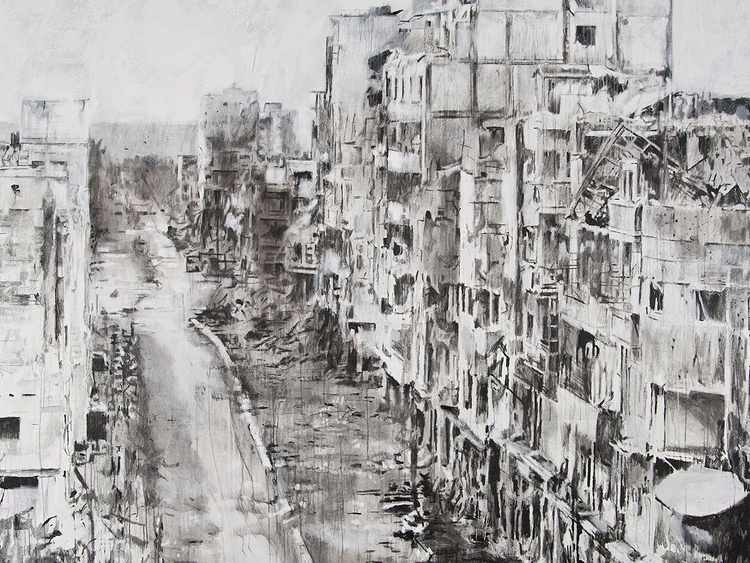
A pathway lined with rubble gradually turns into an endless pile of concrete pieces, twisted metal and torn clothing, blocking the entire staircase leading to the upper floor of the gallery. This dramatic and heart-wrenching installation conveys the gist of Syrian artist Tammam Azzam’s latest show, “The Road”. Through paintings and digital artworks that depict what has been left behind and what lies ahead in Syria, the artist steers his way through the labyrinth of physical and emotional consequences for those who have escaped their war-torn homeland. His simple yet powerful metaphor of a road that leads nowhere raises questions that everyone must think about.
Azzam is known for his multimedia paintings, especially the “Laundry” series, where he used ropes, clothes pegs and found fabrics to speak about life in his city, Damascus. But since the start of the uprising in Syria in the spring of 2011, he has turned to digital media to create artworks that chronicle the tragic events and the ongoing humanitarian crisis in his country. The artist, who now lives in Dubai, has returned to painting for this exhibition with a series titled “Storeys”.
His large acrylic paintings, done in shades of grey, are a stark reminder of the destruction that has happened in Syrian cities such as Damascus, Homs and Aleppo. There are no people to be seen anywhere, except for a few fuzzy figures in one painting, appearing as silent witnesses to the wreckage of war. With no signs of everyday life on the streets or in the abandoned homes, you can feel the atmosphere of loneliness and retreat in these emotionally charged canvasses. Running in between the deserted, desolate buildings and mounds of rubble is a quiet, empty road with no end in sight.
“Amid all this suffering it is a challenge for me to focus on art, but I am doing what comes from within. I wanted to paint my country the way I remember it, but the images I see in the media every day just kept creeping in. My beautiful memories of the past have become fake now, and this is the tragic reality of today. These paintings are about the stories in every storey of these damaged buildings — about the lives and dreams of the people who lived there. I am trying to rebuild this destroyed place in my imagination, but it feels as if we are just walking and walking on the road with no destination visible on the horizon,” Azzam says.
In his digital media prints the artist goes beyond the damaged façades of buildings into individual homes. In a photomontage titled “Wall paper”, a broken sofa, peeling wallpaper and crumbling walls in what was once a cosy, secure home speak about the broken dreams and lives of the Syrian people. In another image, titled “Lighthouse”, an empty room with cracked walls is flooded with water. A buoy floating in the water conveys the helplessness of people who have been caught in a storm and are desperately searching for land. Finally, in “The Road”, a road running through sunny pastures is blocked by a huge wall running right across.
“In the last three years we have seen that there are so many twists and turns and unseen obstacles along the road, and yet in the end there is always a wall blocking the path ahead. Who knows whether this unfinished road will ever be completed,” Azzam says.
Jyoti Kalsi is an arts-enthusiast based in Dubai.
“The Road” will run at Ayyam Gallery Dubai, 11, Alserkal Avenue, Al Quoz until March 3.














